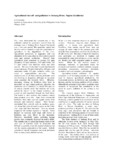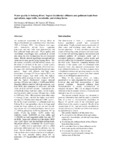Agricultural run-off and pollution in Imbang River, Negros Occidental
- Global styles
- MLA
- Vancouver
- Elsevier - Harvard
- APA
- Help
Share
抄録
This study determined the concentration of key pollutants carried by agricultural run-off from the drainage area of Imbang River, Negros Occidental over a two-year period. The quantities loaded into the river were estimated to assess the contribution of agriculture to the degradation of the river. Agricultural production in sugarcane and rice plantations in the area relied on chemicals to control pests and enhance production. Run-off from agricultural land contained an average 0.2 ppm phosphate, 0.2 ppm ammonia, 0.02 ppm nitrite, and 1.7 ppm nitrate from fertilizer inputs and other sources. The run-off also had 7.4 ppm biochemical oxygen demand, 465 ppm total solids, 296 ppm total suspended solids, 0.4 ppm settleable solids, plus traces of organochlorine pesticides. The concentrations of all these potential pollutants were not alarming or dangerous, although on occasion, some exceeded the tolerable limits. However, increasing reliance on fertilizers often leads to intensified use and related problems. Likewise, the continuing use of chemicals to control field pests is of serious concern given that residues are easily carried by run-off to the nearest waterway and passed on and magnified through the food chain. The health of farm workers who routinely handle these products is at risk. Apart from commercial fertilizers, farm lands received organic wastes from domestic and industrial sources. Most farmers maintained farm animals such as carabaos, goats, and sheep that were allowed to graze on the fields after crops had been harvested. Grazing animals frequently left surface deposits of manure. Some farmers on occasion used sugar mill wastes as fertilizers and road fillers in the haciendas. Moreover, household wastes including human excreta were commonly disposed on nearby fields. The contributions of animal and human wastes to the total load of nutrients could be substantial but difficult to quantify given the manner of production and the varying composition of the wastes. Indeed, agricultural run-off transports non-point pollutants from so many poorly defined sources.
Suggested Citation
Gonzales, G. A. (2008). Agricultural run-off and pollution in Imbang River, Negros Occidental. In T. U. Bagarinao (Ed.), Research Output of the Fisheries Sector Program (Vol. 2. Reports on Fisheries and Aquaculture, pp. 52-59). Quezon City, Philippines: Bureau of Agricultural Research, Department of Agriculture.
Type
Book chapterISBN
9718511776
Related items
Showing items related by title, author, creator and subject.
-
Water quality in Imbang river, Negros Occidental: effluents and pollutant loads from agriculture, sugar mills, households, and shrimp farms
Gonzales, Guadiosa A.; Gonzales, Hernane J.; Sanares, Roman C.; Taberna, Evelyn T. (Bureau of Agricultural Research, Department of Agriculture, 2007)An ecological assessment of Imbang River in Negros Occidental was undertaken from December 1992 to February 1995. The effluents from sugar mills, households, shrimp farms, sugarcane plantations and rice fields were ... -
Households, agriculture, industry, fishing, and fish farming along Imbang River, Negros Occidental
Sanares, Roman C. (Bureau of Agricultural Research, Department of Agriculture, 2007)Interviews were conducted among respondents identified from the households, agriculture farms, sugar mills, and fish farms along the whole stretch of Imbang River, Malisbog River, and Muyao Creek, down to Barangay Balaring ... -
An overview of agricultural pollution in the Philippines: The fisheries sector
Cuvin-Aralar, Maria Lourdes A.; Ricafort, Carl H.; Salvacion, Arnold (World Bank, 2016)This report is part of a national overview of agricultural pollution in the Philippines, commissioned by the World Bank. The overview consists of three ‘chapters’ on the crops, livestock, and fisheries sub-sectors, and a ...




